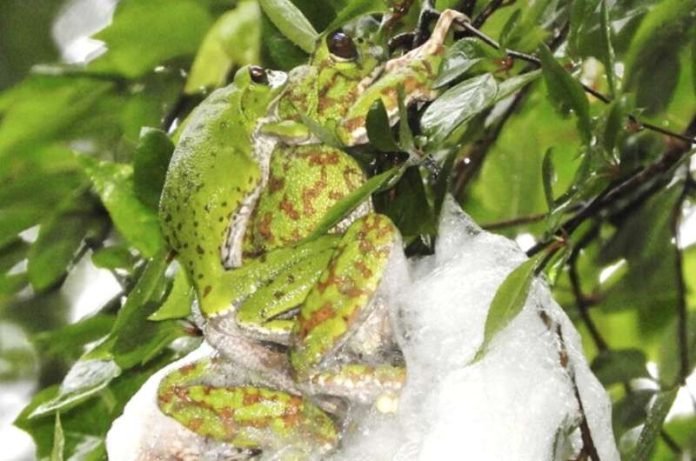
In a fascinating study from Nagoya University in Japan, researchers have uncovered why tree frogs, known for their arboreal lifestyle, sometimes opt to lay their eggs on the ground rather than in the trees.
The study, published in Ecology and Evolution, focused on the forest green tree frog (Zhangixalus arboreus), revealing that this behavior might be an adaptive strategy to protect the eggs from colder temperatures.
Tree frogs are known for their unique egg protection method, creating foam nests from secretions to safeguard their developing offspring.
These nests, which appear as white or light-colored frothy masses, provide a stable environment that not only supports embryo development but also offers a shield against predators.
The research team, led by doctoral student Yukio Ichioka and Professor Kajimura, embarked on this investigation upon noticing foam nests both on the ground and on tree branches near ponds, despite the presence of suitable trees for nest building.
The ground seemed like a riskier choice due to predators, prompting the question of why some frogs chose it over the seemingly safer branches.
To explore this behavior, the researchers compared the temperatures within foam nests located on the ground and in trees, alongside environmental temperatures.
They also assessed the hatchability of eggs from both locations by tracking the number of eggs that successfully hatched into tadpoles.
Their findings revealed that ground nests offer a warmer environment for the eggs, particularly at night when temperatures drop. This warmth is crucial for increasing the eggs’ chances of survival and hatching, especially in colder climates or higher altitudes where these frogs are found.
This adaptive strategy highlights the frogs’ ability to balance the risks of predation against the need for a suitable thermal environment for their offspring, suggesting a complex decision-making process based on environmental conditions.
The study not only sheds light on the previously unknown reasons behind ground egg-laying in tree frogs but also contributes to our understanding of amphibian spawning behavior and adaptation strategies to thermal environments.
This research is particularly timely, offering insights into how climate and environmental changes might affect animal behaviors and evolution.
Looking ahead, the team plans to extend their research to other frog species, including Zhangixalus viridis in Okinawa, to further explore the ecological and evolutionary implications of foam nest building and egg-laying strategies.
This ongoing research could provide broader insights into amphibian ecology and help predict how these creatures might adapt to the changing climate.
The research findings can be found in Ecology and Evolution.
Copyright © 2024 Knowridge Science Report. All rights reserved.



